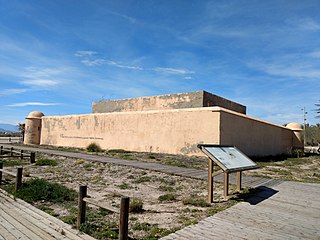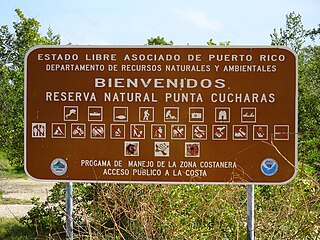Related Research Articles
The Aymara Lupaca Reserved Zone was a protected area in southeastern Peru, set up in 1996, with an area of around 200,000 hectares. It was expanded in January 2006, but the decree was repealed in 2009.

There are currently 182 Protected Natural Areas in Mexico, covering 25.4 million hectares in total. They are protected and administered by the National Commission of Protected Natural Areas, a federal agency. CONANP administers:
Mexican Flora and Fauna Protection Areas comprise 29 protected natural areas of Mexico administrated by the National Commission of Protected Natural Areas, an agency of the federal government.

Valdivian Coastal Reserve is a natural reserve located in the Cordillera Pelada, in Los Ríos Region of Chile, near Corral.
Oncol Park is a natural reserve located 32 km (20 mi) from the city of Valdivia, Chile. The park has an area of 7.54 km2 (3 sq mi) of which most lies on Cerro Oncol, the highest peak of the Valdivian Coast Range, but is only 5 km (3 mi) from the coast. Oncol Park is located in an area of 15 km2 (6 sq mi) of continuous Valdivian temperate rain forest. From the peak of Cerro Oncol it is possible to see Llaima Volcano, Villarrica Volcano and even Mount Tronador on the international border of Chile and Argentina. The park is property of the wood pulp enterprise Celulosa Arauco y Constitución.
Carlos Anwandter Nature Sanctuary is protected wetland in Cruces River about 15 km (9 mi) north of Valdivia, Chile. The sanctuary is named after the German politician Carlos Anwandter who settled in Valdivia in 1850. This sanctuary provides a home for many native waterbird species to flourish, and contains roughly 119 species of birds alone. The most numerous bird species in the sanctuary are the black-necked swans followed by coots.

Bahía Portete – Kaurrele National Natural Park is a national natural park in Uribia, La Guajira, Colombia. The northernmost national park of mainland South America is located at the Caribbean coast of the La Guajira peninsula in Bahía Portete, between Cabo de la Vela and Punta Gallinas. Established on December 20, 2014, it is the most recently designated national park of the country. As of 2017, 59 nationally defined protected areas are incorporated in Colombia. The park hosts a high number of marine and terrestrial species.

The Bosque el Nixticuil is an old-growth forest located northwest of the Metropolitan Zone of Guadalajara in the Mexican town of Zapopan. An urban forest, it is encroached by the metropolitan area's constant growth. It is mostly composed of oak, holm oak and pine.

Bahía de Portete is a bay in La Guajira, Colombia. It lies approximately 30 miles (48 km) from the Venezuelan border on the Guajira Peninsula in the northeast region of Colombia. The bay opens to the Caribbean Sea. A large coal terminal lies at the mouth of the bay, and the bay's inlet is less than 1 mile (2 km) wide.

Sierra de Quila, officially the Sierra de Quila Flora and Fauna Protection Area, is a Mexican Flora and Fauna Protection Area in the state of Jalisco, Mexico. It has an area of 15,193 hectares, and is located within six municipalities: San Martín de Hidalgo, Tecolotlán, Cocula, Atengo, Tenamaxtlán, and Ameca.
The National System of Protected Areas (SINAP) is the Colombian national park administrator. It is a department under the Ministry of the Environment, Housing and Regional Development responsible for the conservation and sustainable use of biological diversity. SINAP was established after Colombia signed the Convention on Biological Diversity through Law 165 of 1994, and has been the primary activity of the Colombian Government regarding the conservation of biodiversity. The areas of the Park System supply 25 million people with water.
Área Costera Protegida Punta Curiñanco is a natural reserve 40 km (25 mi) from the city of Valdivia, Chile. The park has an area of 80 ha on the headland of Punta Curiñanco at just at the northern end of Curiñanco beach and village and on the western side of the Valdivian Coast Range. Punta Curiñanco covers area that includes different types of Valdivian temperate rain forest as well as coastal shrublands, wetlands and sea-side rocks.
The following is a timeline of the history of the city of Ponce, Puerto Rico.

The Casa Fuerte de la Cruceta or the Casas Fuertes is a privately owned castle and coastal defense fortress in Almería, Province of Almería, Andalusia, Spain.
El Jabalí Flora and Fauna Protection Area is a protected natural area located in Colima State, México. It covers an area of 51.79 km2, which includes forests and several natural lakes.

Reserva Natural Punta Cucharas is a nature reserve in Barrio Canas, Ponce, Puerto Rico. It consists of both a land area component as well as an offshore marine area. The land component has an area of 698 cuerdas while the marine component has an expanse of 3,516 cuerdas, for a total area of 4,214 cuerdas. The Reserve consists of mangrove ecosystems, coastal sand dunes, a saline lagoon known as Laguna Las Salinas, open water, and a century-old local community. The lagoon occupies and area of 347,898 m2 Ecological protection is managed and enforced by the Puerto Rico Department of Natural and Environmental Resources. Eight activities are allowed at the Reserve: scuba diving, boating, fishing, hiking, sun bathing, photography, bird watching and canoeing. Activities prohibited are: Camping, crabbing/trapping, horseback riding, water crafting, and hunting. Pets, ATVs, and fireplaces are also prohibited.
El Bosque Urban Park is a protected wetland and forest in the city of Valdivia, south-central Chile. The park is owned by the real estate company SOCOVESA that developed the adjacent neighborhood of El Bosque. The park originated in 1997 as a private park open only to residents of the neighborhood. It was opened to the public in 2004, the same year administration was transferred to the ad-hoc organisation Comité Ecológico Lemu Lahuen.
Papigochic Flora and Fauna Protection Area is a protected area in Chihuahua state of Mexico. It covers an area of 2227.64 km2 in the eastern Sierra Madre Occidental. To the northwest it adjoins Tutuaca Flora and Fauna Protection Area.
Campo Verde Flora and Fauna Protection Area is a protected area in northern Mexico. It covers an area of 1080.67 km2 in northwestern Chihuahua, on the border with Sinaloa. It is at the eastern edge of the Sierra Madre Occidental, where it meets the Chihuahuan Desert.
References
- ↑ CODEFF - Misión
- ↑ Diversidad Biológica del Área Costera Protegida Punta Curiñanco. 2003. Comité Pro Defensa de la Fauna y Flora.